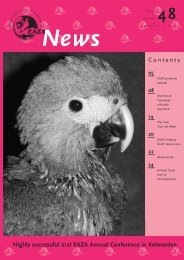EAZA News 57-12 - European Association of Zoos and Aquaria
EAZA News 57-12 - European Association of Zoos and Aquaria
EAZA News 57-12 - European Association of Zoos and Aquaria
You also want an ePaper? Increase the reach of your titles
YUMPU automatically turns print PDFs into web optimized ePapers that Google loves.
Termites nest<br />
photo eugène bruins/artis royal zoo<br />
A 1.5 - year-old nest <strong>of</strong> the African termite (Macrotermes bellicosus) was<br />
added to the insect house in July 2006. The nest, which was kindly donated<br />
by Basel Zoo, then weighed 240 kg <strong>and</strong> measured 90 cm in height. The<br />
nest, grown in two plastic crates placed on a board, was transported by<br />
the transport firm Ekipa. A temperature just below 26°C kept the termites<br />
inside their nest, so no further protection was needed.<br />
The nest is now housed in an 4.5 x 2.1 m enclosure. The height right<br />
above the nest is 3.1 m. The nest was placed on a 380 x 160 cm bed <strong>of</strong><br />
loam <strong>and</strong> clay, with a depth <strong>of</strong> 45 cm. Water flows around this area, to<br />
protect the termites from escaping (the insect house mainly consists <strong>of</strong><br />
wood…). A 50 mm diameter PVC pipe goes from the nest through the<br />
concrete floor <strong>of</strong> the enclosure to groundwater level. With this constant<br />
access to the groundwater, the termites can regulate the moisture level<br />
within the nest themselves. The temperature is kept at 27°C.<br />
The termites are fed several times a week with hay, straw, wood or elephant<br />
dung (a favourite!) <strong>and</strong> <strong>of</strong>ten the termites can be spotted eating. About<br />
once every week, thous<strong>and</strong>s <strong>of</strong> termites suddenly start exp<strong>and</strong>ing the<br />
nest, producing a new bump 35 cm in diameter, about 3 cm thick, within<br />
approximately two hours. The educational presentation now consists <strong>of</strong><br />
an information panel <strong>and</strong> a video screen. We plan to construct a camera<br />
above the feeding site for live footage. Visitors are much attracted by this<br />
new, interesting enclosure.<br />
Butterfly pavilion<br />
The insect collection in Artis Royal Zoo grew even more after the inauguration<br />
<strong>of</strong> the butterfly pavilion on 4 October 2006, by Her Royal Highness<br />
Princess Margriet. A team <strong>of</strong> butterfly specialists, architects, l<strong>and</strong>scape<br />
artists, botanists <strong>and</strong> educators worked together to turn a unique concept<br />
into reality in the pavilion’s design <strong>and</strong> construction. The aim was not<br />
to reproduce an entirely natural environment, but to create a spatial<br />
experience in a 1000 m2 large greenhouse. Butterflies flutter through the<br />
air <strong>and</strong> alight on flowers in colourful patches as visitors w<strong>and</strong>er around<br />
freely. The pavilion is an isl<strong>and</strong> in the zoo <strong>and</strong> the pavilion itself also has a<br />
pattern <strong>of</strong> green <strong>and</strong> colourful isl<strong>and</strong>s. This pattern reflects the atmosphere<br />
<strong>of</strong> the historical zoo with its curved paths <strong>and</strong> surprises around every corner.<br />
new enclosures<br />
The pavilion is kept at a constant 27°C <strong>and</strong> a large waterfall ensures a<br />
high relative humidity. A specially designed ro<strong>of</strong>, consisting <strong>of</strong> three layers<br />
<strong>of</strong> plastic between which air is blown, provides the greenhouse with much<br />
natural sunlight. No additional lighting is used to increase butterfly activity,<br />
as no butterfly house could really assure us that this method would help.<br />
Seven main species<br />
Visitors in the butterfly pavilion can enjoy a wealth <strong>of</strong> tropical butterfly<br />
species, <strong>of</strong> which seven are selected to be the main species; the postman<br />
butterfly (Heliconius melpomene), the glasswing (Greta oto), the morpho<br />
butterfly (Morpho sp.), the owl butterfly (Caligo sp.), the atlas moth<br />
(Attacus atlas), the Thoas swallowtail (Papilio thoas) <strong>and</strong> the paper butterfly<br />
(Idea leuconoe). Breeding is done mostly for educational purposes<br />
<strong>and</strong> mainly with postman butterflies, since their pupae are difficult to<br />
transport. Visitors can see the caterpillars grow in a separate breeding area<br />
<strong>of</strong> 50 m2 next to the butterfly house, <strong>and</strong> how once a week newly arrived<br />
pupae are put on a needle before being placed in the pupae cabinet.<br />
photo eugène bruins/artis royal zoo<br />
More than butterflies<br />
One will not only find butterflies in the butterfly pavilion, but other<br />
species as well. Leafcutter ants have to walk 7 m from their nest through<br />
a transparent tube to reach their feeding terrarium. Some visitors are<br />
pleasantly surprised when they spot a Guyana grasshopper (Tropidacris<br />
collaris) or a fruit beetle (Pachnoda marginata) between the plants.<br />
By releasing only males, it is guaranteed that no plague <strong>of</strong> these species<br />
develops. Several bird species are planned to be released for biological<br />
control. Hummingbirds are deployed to combat spiders, as they construct<br />
their nests from spider web gossamer. Quails will forage on the floor <strong>of</strong><br />
the pavilion, functioning as a ‘natural’ enemy to the ‘local’ ants. The<br />
excreta <strong>of</strong> these <strong>and</strong> other bird species are vital to the glasswing butterfly,<br />
which needs the minerals in these faeces as food. •<br />
With the insect house, Artis Royal Zoo has created a new benchmark<br />
for invertebrate exhibitions in the Netherl<strong>and</strong>s <strong>and</strong> Europe. The butterfly<br />
pavilion further reinforced this reputation. Both exhibitions attract many<br />
visitors.<br />
eaza news <strong>57</strong><br />
2007<br />
23

















